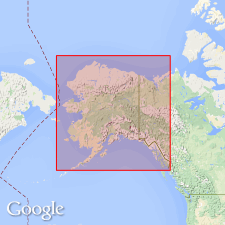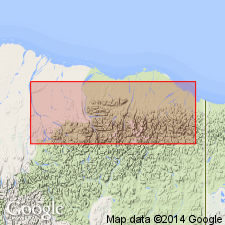
- Usage in publication:
-
- Nuwok formation
- Modifications:
-
- First used
- AAPG geologic province:
-
- Alaska Northern region
Summary:
Briefly mentioned as the Pliocene formation which in Alaska underlies Gubik sand in many places.
Source: GNU records (USGS DDS-6; Menlo GNULEX).

- Usage in publication:
-
- Nuwok Member*
- Modifications:
-
- Adopted
- Revised
- Age modified
- AAPG geologic province:
-
- Alaska Northern region
Summary:
Nuwok Formation of Dall (1919, 1920), of Leffingwell (1919) and MacNeil (1957) is adopted as Nuwok Member (uppermost of 3) of Sagavanirktok Formation. Type section designated as low bluffs along east side of Carter Creek, 69 deg 57'N, 144 deg 39'30"W about 2.4 km (1.5 mi) south of Camden Bay, northern AK. Type section is only known occurrence of unit. Consists of sequence of cross-bedded sand capped by pebble conglomerate overlain by pebbly mudstone and siltstone with few limestone interbeds. Is about 80 m (270 ft) thick. Conformably overlies Franklin Bluffs Member (new) of Sagavanirktok Formation. Age is late Miocene(?) and Pliocene based on microfossils identified by H.R. Bergquist.
Source: GNU records (USGS DDS-6; Menlo GNULEX).
For more information, please contact Nancy Stamm, Geologic Names Committee Secretary.
Asterisk (*) indicates published by U.S. Geological Survey authors.
"No current usage" (†) implies that a name has been abandoned or has fallen into disuse. Former usage and, if known, replacement name given in parentheses ( ).
Slash (/) indicates name conflicts with nomenclatural guidelines (CSN, 1933; ACSN, 1961, 1970; NACSN, 1983, 2005, 2021). May be explained within brackets ([ ]).

